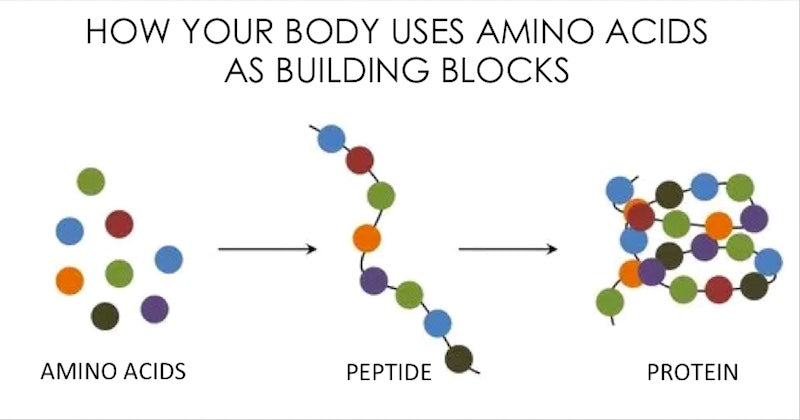What Are Proteins (and What Do They Do)?

Ah, the essential questions regarding the basic units of life. When we begin to examine the building blocks of creation we stumble across a few trends and repeat terms. Protein, which is an essential part of all living organisms, is a regular focus of scientific study. So, what are proteins made of, and what do proteins do?
Proteins are the most diverse molecules in biology, and they serve an even more diverse array of functions, from detecting different colors of light in our eyes, to physically flexing our muscles in order to do physical work. Life on Earth is exclusively made up of organisms with DNA, and the exclusive purpose of DNA is to code for proteins. Specifically, the DNA of an organism is made of thousands of genes, and each gene encodes a single, unique protein.
There are 22 “protein-coding” amino acids. These organic compounds are composed of an amino (NH2) group, a weakly acidic carboxyl group (COOH), and a side chain (group of atoms) known as the R group. The R group is what differentiates each amino acid, giving it unique properties from the others.
Primary structure of proteins
A strand of double-helix DNA is separated into two single helices, which are known as mRNA. Ribosomes pull free-floating amino acids from the cytoplasm and attach them in groups of three to corresponding base pairs on the mRNA molecule. The order of amino acids depends on the order of base pairs in the DNA strand, and ultimately, the amino acid sequence is detached from the mRNA and folded into a peptide.
This peptide is the primary structure of a protein. The amino acid monomers form peptide bonds with one another holding them in place.
The long chain formed through many consecutive peptide bonds is referred to simply as a peptide and can range from 2 to 50 amino acid residues in length. A polypeptide is a much longer chain of amino acids. Ultimately, a protein is made up of one or more polypeptides arranged in specific and functional manner.
Secondary structure of proteins
Once the primary structure is formed, the chain of amino acids begins to take on a shape. This shape is the hallmark of a protein’s secondary structure. The amino acids in the peptide Hydrogen has a slight positive charge so it is gently attracted to electronegative atoms, allowing a bond to form between two distant amino acids that may be physically near each other thanks to the fold of the protein. As these bonds form at different junctures along the peptide chain, the proper secondary shape begins to arise. It’s important to note that a protein’s unique shape and components dictate its function.
Tertiary structure of proteins
The next structure, or the tertiary structure, indicates the proper three-dimensional shape of a protein structure. The shapes formed in the secondary structure begin to be compacted into a globular shape. The bonds that drive this process are primarily hydrophobic responses causing compounds to arrange accordingly but there are also several other types of bond that help to build the protein’s tertiary shape. The quaternary structure describes a protein that contains two or more polypeptide amino acid chains. In this final stage, the polypeptide chains fall into proper alignment with one another and find a final compact protein structure.
WHAT DO PROTEINS DO? PROTEIN FUNCTIONS AND CLASSIFICATIONS
Proteins serve thousands of purposes in life, and their structures are intimately related to their functions. Proteins can be broken down into five classes based on their role in the body.
Proteins, such as immunoglobulin, can act as antibodies protecting the body from foreign elements.
Other proteins, known as enzymes, assist in nearly every reaction in cells and help new molecules form by referencing the cell’s DNA.
Messenger proteins execute the communication between tissues, organs, and individual cells. Growth hormones are examples of these messenger proteins.
Proteins also act as structural elements in the body, helping cells maintain shape and enabling the body to move properly. Keratin, which is one of the major components of our outer layer of skin, is a structural protein.
The final type of proteins are transport or carrier proteins, like ferritin, that help move molecules both in cells and through the body.Know your body, and gain mastery of your life. Understanding the vital nuances of our body and mind gives us a much-needed edge in modern society. The genomic information contained within your DNA helps to shape your unique human traits and as a result your specific needs and affinities. Our expert staff at MelixGXTM break down the contents of your genetic material and provide you with feedback that will help maximize your health wellness and quality of life. “It starts with MelixGXTM,” but the success will be yours to enjoy.

